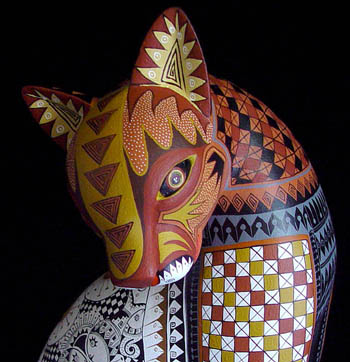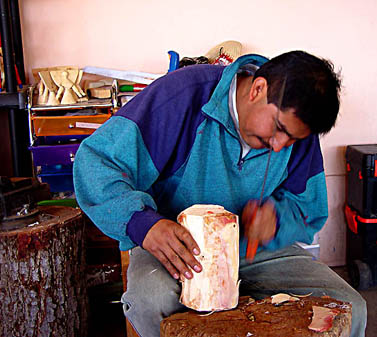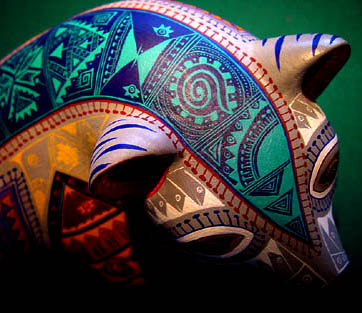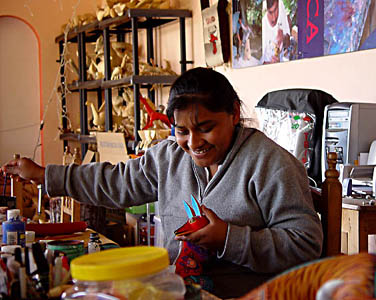Alebrije is a Spanish word meaning "imaginary" or "fantasy". It is used to describe a style of fanciful and surreal animal carvings with near psychedilic paint schemes that has developed during the last 20 years in three small villages in the State of Oaxaca 200 miles south of Mexico City. Alebrije carvings have become the center of a marketing phenomenon that has spread not only to the United States and Canada, but also to several European countries.
 The carvers are Zapotec Indians who are descendants of the Pre-Columbian Zapotec civilization that reached the height of its development between 200 and 500 AD. This culture, plus the earlier Olmec and Mixtec cultures that flourished as early as 1200 BC, and the influence of the Spanish conquest in the 16th century, have all contributed to this rich art form that exists today in southern Mexico.
Within this artistic heritage, an impoverished subsistence farmer named Manuel Jiménez began to carve imaginary creatures in the early 1980's. Fortunately, the outside world discovered and encouraged Jimenez to pursue his art work. The style was quickly adopted by others, and in response to a growing market demand, these woodcarvings have become a family production enterprise with members collaborating and using their combined talents to create these delightful creatures. Soon, dozens of families were producing them. Jiménez never dreamed his creations would generate a market that would bring buyers from all over the world to his little village, nor would anyone have anticipated that the demand would continue to grow for almost 20 years.Alebrije carvers are continually striving to improve their product and further develop their skills. This evolution is particularly noticeable when comparing the carvings pictured in a book written in 1992 with the ones now being produced. Continued improvement has brought recognition in the art world to many of the carvers.
The carvers are Zapotec Indians who are descendants of the Pre-Columbian Zapotec civilization that reached the height of its development between 200 and 500 AD. This culture, plus the earlier Olmec and Mixtec cultures that flourished as early as 1200 BC, and the influence of the Spanish conquest in the 16th century, have all contributed to this rich art form that exists today in southern Mexico.
Within this artistic heritage, an impoverished subsistence farmer named Manuel Jiménez began to carve imaginary creatures in the early 1980's. Fortunately, the outside world discovered and encouraged Jimenez to pursue his art work. The style was quickly adopted by others, and in response to a growing market demand, these woodcarvings have become a family production enterprise with members collaborating and using their combined talents to create these delightful creatures. Soon, dozens of families were producing them. Jiménez never dreamed his creations would generate a market that would bring buyers from all over the world to his little village, nor would anyone have anticipated that the demand would continue to grow for almost 20 years.Alebrije carvers are continually striving to improve their product and further develop their skills. This evolution is particularly noticeable when comparing the carvings pictured in a book written in 1992 with the ones now being produced. Continued improvement has brought recognition in the art world to many of the carvers.
 Jacobo Angeles Ojeda is one such artist, having been honored twice in the United States. I met Jacobo and his wife Maria while attending an Elderhostel in Oaxaca, Mexico. As a fellow carver with many questions, I was invited to visit their home, meet their extended family, take photographs, and observe how they create these unusual and beautiful carvings.In the Ojeda family, the men are the carvers. The women do most of the detail painting by hand, but many of the carvers paint as well. Children work by sanding, filling voids in the wood, and putting base coats of paint on th wood. The more skilled family members collaborate to produce the detailed and intricate artwork. Typically, it is a family business in which everyone participates, but regardless of the hierarchy of work, each carving is unique.
Jacobo Angeles Ojeda is one such artist, having been honored twice in the United States. I met Jacobo and his wife Maria while attending an Elderhostel in Oaxaca, Mexico. As a fellow carver with many questions, I was invited to visit their home, meet their extended family, take photographs, and observe how they create these unusual and beautiful carvings.In the Ojeda family, the men are the carvers. The women do most of the detail painting by hand, but many of the carvers paint as well. Children work by sanding, filling voids in the wood, and putting base coats of paint on th wood. The more skilled family members collaborate to produce the detailed and intricate artwork. Typically, it is a family business in which everyone participates, but regardless of the hierarchy of work, each carving is unique.
 The wood used to produce the Alebrije carvings comes from the copal tree, as it is commonly called. Unfortunately, the trees near the villages have been over-harvested and the wood must now be transported from mountain forests miles away. Burros bring it out of the mountains in 3 to 4-ft. lengths that have diameters of 6 in. or more. No one expected the carving boom to last this long, and only recently have attempts been made to replant the trees in the local area.The copal tree has small leaves and is a hardwood. Its wood is similar to Basswood in color, has a very fine grain, and there is almost no discernable difference between heartwood and sapwood. It exudes pitch that is sticky and smells like pine, but the tree definatley has leaves and not needles. When dry, the wood sands to a porcelain-like finish.Carvers are very careful not to use wood with insect holes since it may contain eggs from the wood-eating powder post beetle. As a preventative measure, the carvings are soaked overnight in gasoline before they are dried and painted. Collectors might add an additional element of protection by freezing their carvings for a week.
If the carvings are going to be stored for any length of time, a mothball or two included in the box might be advisable. Alebrije carvers are extremely resourceful and innovative with their design components. They will use rawhide to make fins for reptiles, cactus spines for teeth, and animal hair for the mains and tails of their creatures. Some carvers even make their own detail paint brushes using animal or human hair. Today, most painting is done with modern acrylic paints, since the aniline dyes originally used faded too quickly.Jacobo and his two brothers graciously took half a day off their work to give me a tour of their family carving operation.
The wood used to produce the Alebrije carvings comes from the copal tree, as it is commonly called. Unfortunately, the trees near the villages have been over-harvested and the wood must now be transported from mountain forests miles away. Burros bring it out of the mountains in 3 to 4-ft. lengths that have diameters of 6 in. or more. No one expected the carving boom to last this long, and only recently have attempts been made to replant the trees in the local area.The copal tree has small leaves and is a hardwood. Its wood is similar to Basswood in color, has a very fine grain, and there is almost no discernable difference between heartwood and sapwood. It exudes pitch that is sticky and smells like pine, but the tree definatley has leaves and not needles. When dry, the wood sands to a porcelain-like finish.Carvers are very careful not to use wood with insect holes since it may contain eggs from the wood-eating powder post beetle. As a preventative measure, the carvings are soaked overnight in gasoline before they are dried and painted. Collectors might add an additional element of protection by freezing their carvings for a week.
If the carvings are going to be stored for any length of time, a mothball or two included in the box might be advisable. Alebrije carvers are extremely resourceful and innovative with their design components. They will use rawhide to make fins for reptiles, cactus spines for teeth, and animal hair for the mains and tails of their creatures. Some carvers even make their own detail paint brushes using animal or human hair. Today, most painting is done with modern acrylic paints, since the aniline dyes originally used faded too quickly.Jacobo and his two brothers graciously took half a day off their work to give me a tour of their family carving operation.
 They knew I wanted to see and take photos of the copal tree and to examine firsthand the wood used for carving. They decided to take me up the mountain to where a few of the trees were growing. When we got to a large copal tree, Jacobo cut off a branch and trimmed it with his machete. It soon began to take shape as a 10-in.-tall coyote with its head up, howling at the moon. All of the roughing was done with rapid strokes, the machete bearly missing his fingers and never once hitting the stone that he used as a workbench.While Jacobo worked, I showed him and his brothers a small Scandinavian-style Santa I had carved during my trip and offered it as a gift. I showed him the four little gouges I had used for the work. Jacobo made a few cuts with each gouge and showed little interest in them. Then he saw the short-bladed carving knife I brought, and his eyes lit up. Alebrije carvers often use kitchen knives that are modified in length and width on a grinding wheel. He used my knife and finished the coyote right there.
They knew I wanted to see and take photos of the copal tree and to examine firsthand the wood used for carving. They decided to take me up the mountain to where a few of the trees were growing. When we got to a large copal tree, Jacobo cut off a branch and trimmed it with his machete. It soon began to take shape as a 10-in.-tall coyote with its head up, howling at the moon. All of the roughing was done with rapid strokes, the machete bearly missing his fingers and never once hitting the stone that he used as a workbench.While Jacobo worked, I showed him and his brothers a small Scandinavian-style Santa I had carved during my trip and offered it as a gift. I showed him the four little gouges I had used for the work. Jacobo made a few cuts with each gouge and showed little interest in them. Then he saw the short-bladed carving knife I brought, and his eyes lit up. Alebrije carvers often use kitchen knives that are modified in length and width on a grinding wheel. He used my knife and finished the coyote right there.
 When we returned to the village, it was obvious that the rest of the family had been working all morning. Even six-year-old Ricardo, Jacobos' son, was sanding carvings.I suspect that the carving progresses much faster than the painting since many unpainted carvings were drying in the sun. A small project must dry for a week before it is ready to paint. A larger one could take as long as six weeks to dry. Small cracks do appear in the wood and are filled with a mixture of glue and sawdust.
When we returned to the village, it was obvious that the rest of the family had been working all morning. Even six-year-old Ricardo, Jacobos' son, was sanding carvings.I suspect that the carving progresses much faster than the painting since many unpainted carvings were drying in the sun. A small project must dry for a week before it is ready to paint. A larger one could take as long as six weeks to dry. Small cracks do appear in the wood and are filled with a mixture of glue and sawdust.
Ninety percent of the carvings are made in the villages of San Martin Tilcajete, Arrazola and La Union Tejalapan, near the city of Oaxaca. The many carving families share very little of their designs and methods with their neighbours. As a result, the carvings vary dramatically from home to home. Simple and common designs are evident in all the family showrooms, but outstanding carvings will be found as well in any studio.
|




